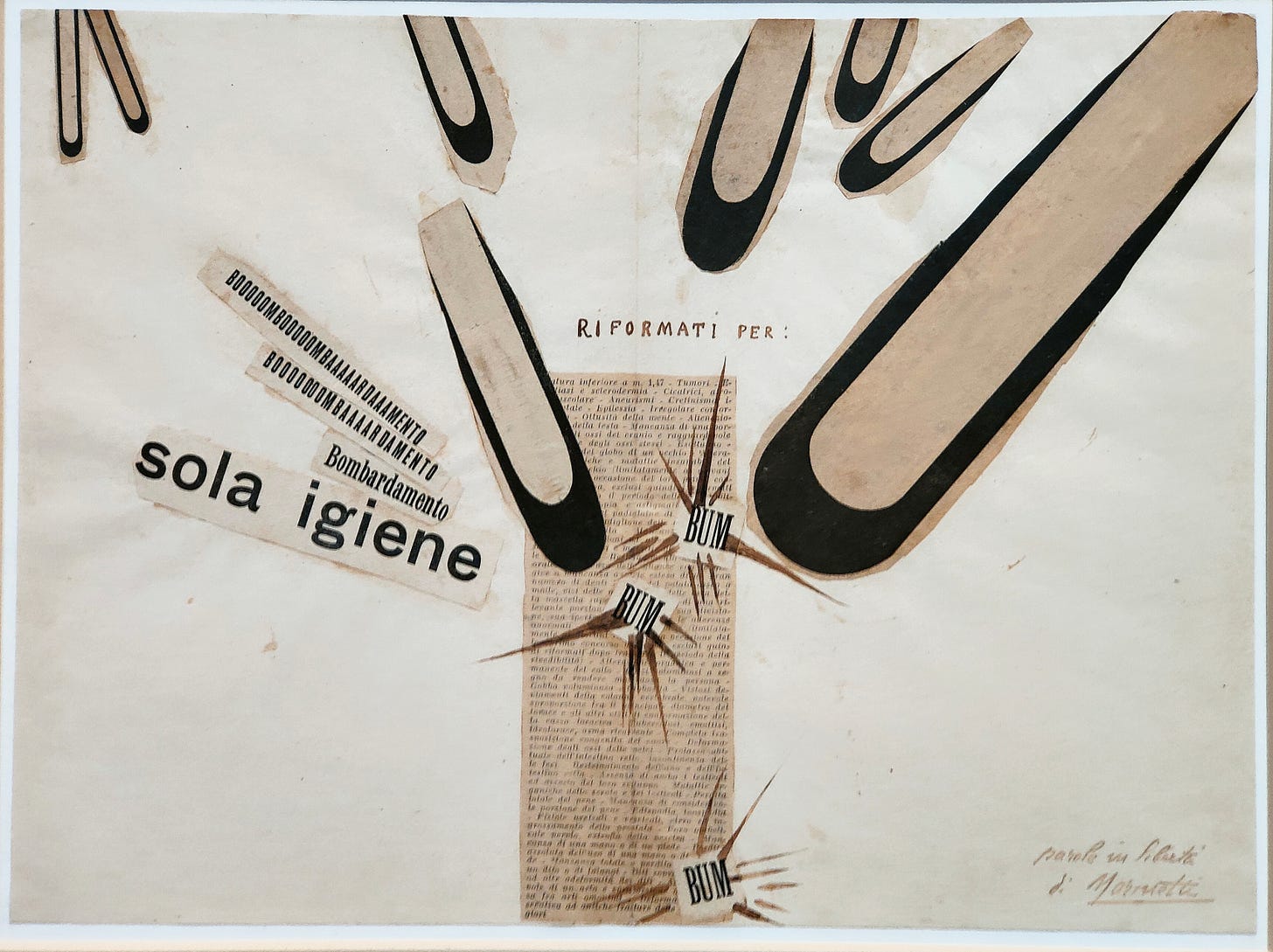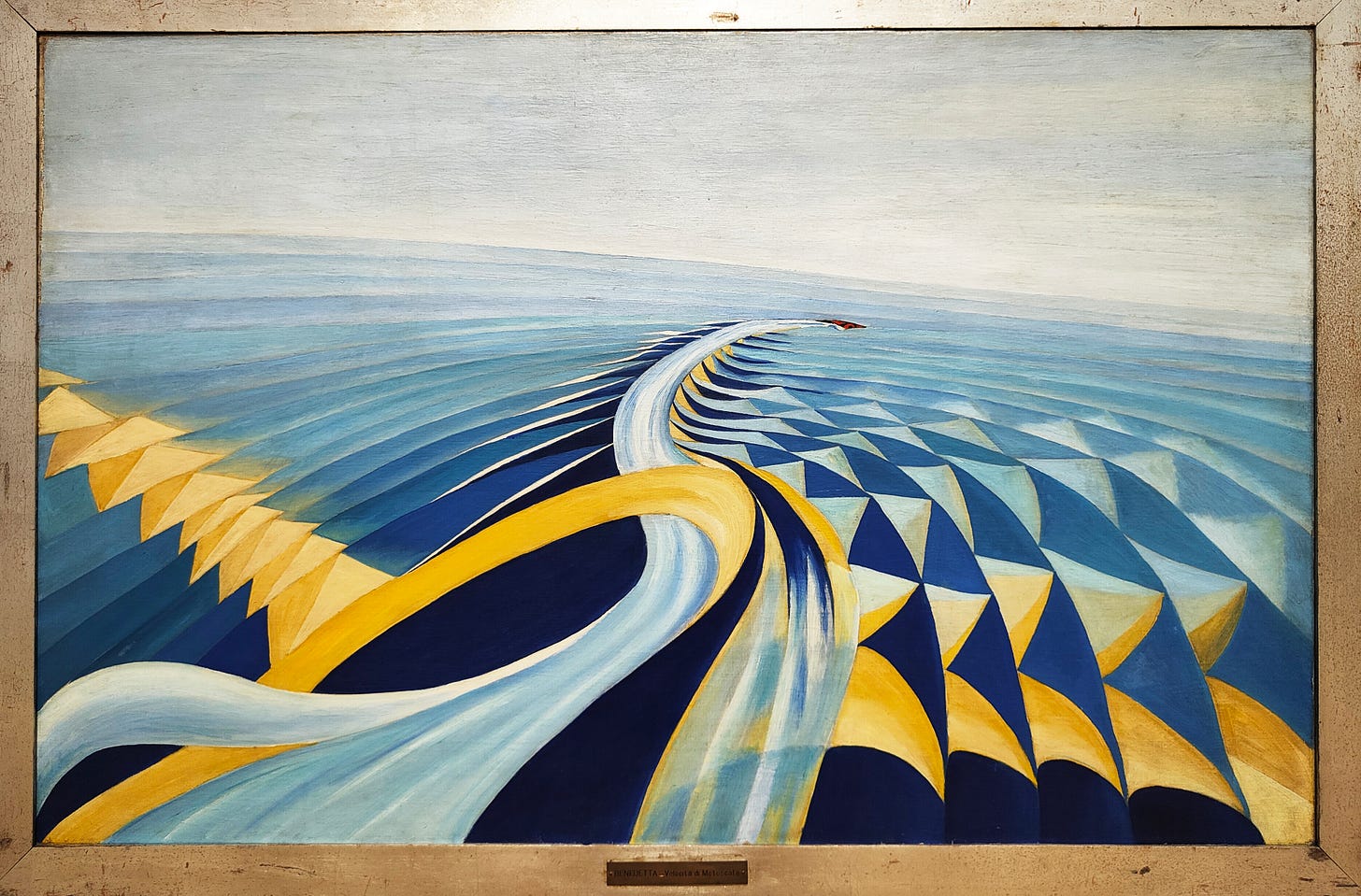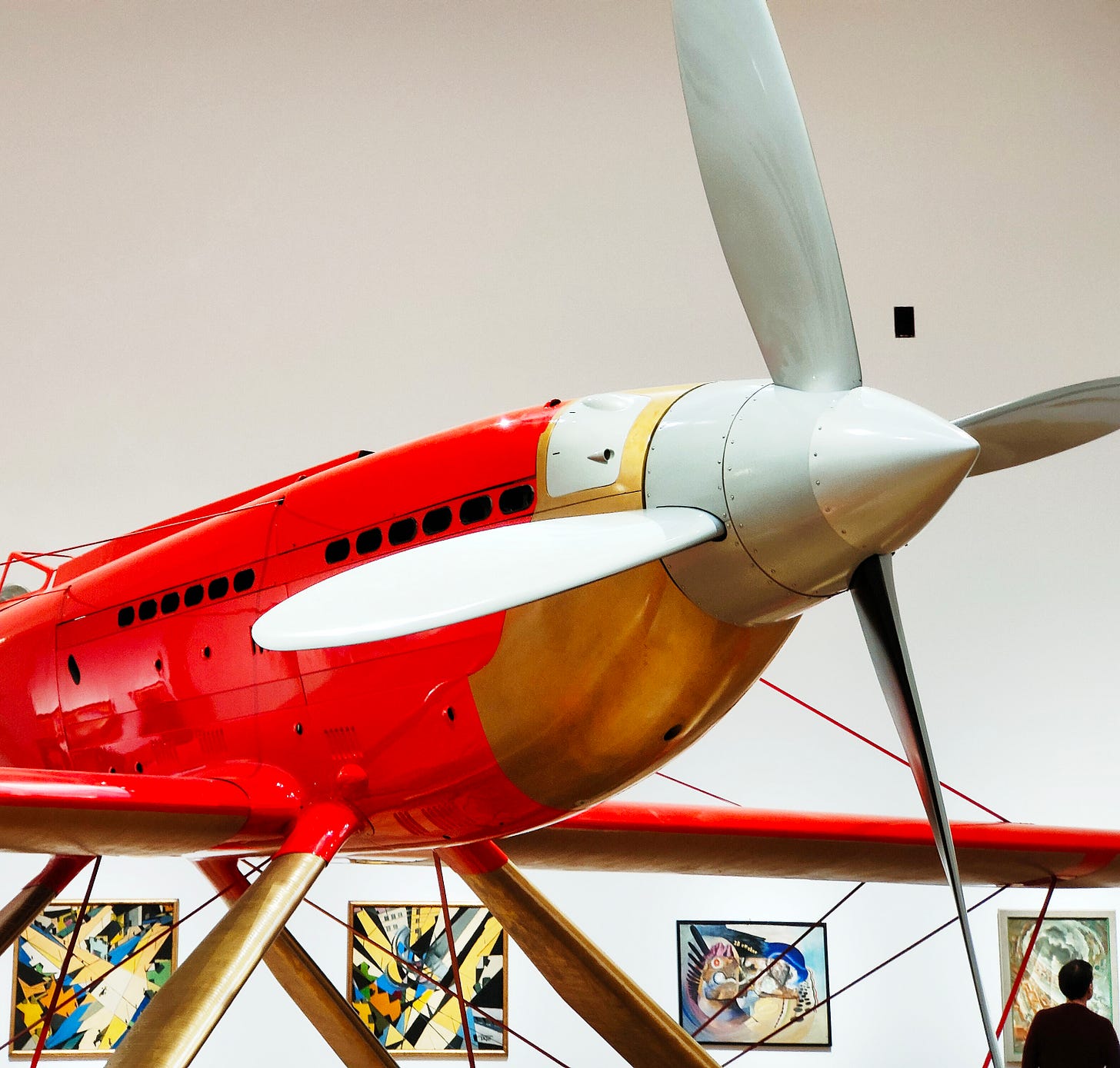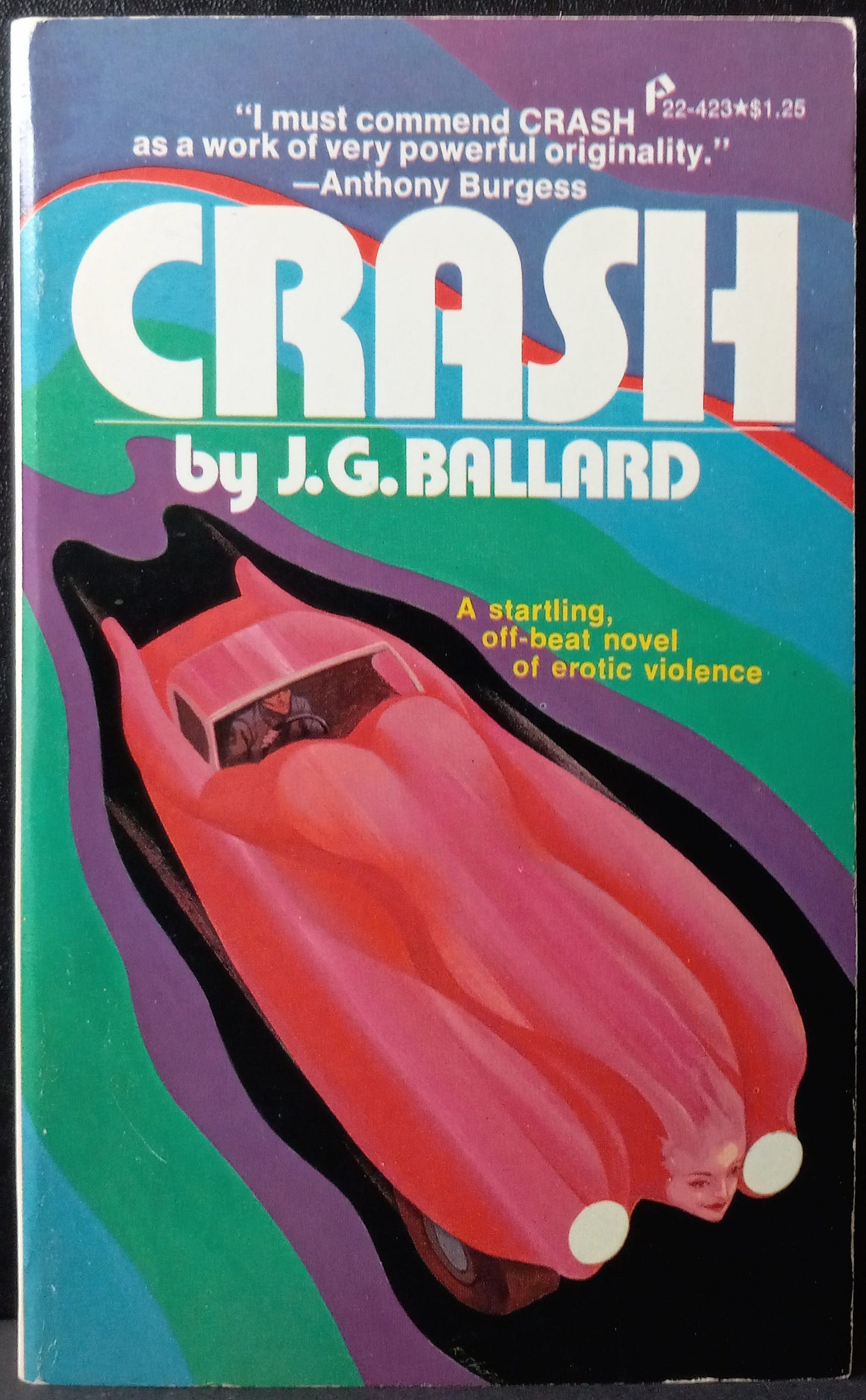Crash! Bang! Boom! The exhibition "The Age of Futurism" collides head-on into the present. At GNAM in Rome.
The current ruling party in Italy launched the exhibition, "Il Tempo del Futurismo" to bank on the cultural legacy of the 19th century Italian avant-garde. Was the effort worthwhile?
The GNAM, Galleria Nazionale di Arte Moderna (National Gallery of Modern Art) has spent over a year and a half assembling a large scale exhibition on the Futurist movement, Il Tempo del Futurismo (The Age of Futurism). GNAM has become the de facto cultural base for the current right wing government headed by Giorgia Meloni; this is now the second exhibition expressly addressing the question of conservative culture to be held there. I already wrote about their last foray into Tolkein’s Hobbit-world, so I couldn’t resist doing the same with latest show on Futurism, yet another subject dear to Meloni’s party, the Fratelli d’Italia (Brothers of Italy—FDI).
So much has been written on this exhibition since it opened at the beginning of December that I could expend an entire newsletter just summarizing the numerous comments, both negative and positive, that are streaming over the media outlets. First off, it is a show well worth seeing: the Futurists, one of the earliest truly radical avant-garde movements of the 19th century, have never ceased to fascinate. And such a large exhibition is a rarity in and of itself, the last one to take place in Rome at this scale—Futurismo 1909 – 1944 Arte, architettura, spettacolo, letteratura, pubblicità was held in 2001. The Guggenheim in New York pulled together a similarly comprehensive overview in 2014, Italian Futurism, 1909–1944: Reconstructing the Universe, that took up almost the entire space of the museum.

This latest show on the Futurist movement got its start when the government’s then cultural minister Gennaro Sangiuliano, gave this project top priority. Sangiuliano, not known as a cultural erudite, was largely responsible for decimating the top tier of international museum directors as soon as he was appointed to his ministerial position, replacing them with questionably qualified party affiliates. However, it didn’t take long until he was caught up in a paltry sex scandal and resigned in disgrace. This may indeed be why there are so many conflicting accounts on how the exhibition evolved into its current over-expanded format. Vittorio Sgarbi, once undersecretary to Sangiuliano, and before he resigned for having allegedly trafficked in forged paintings, suggested the exhibition adopt a wider scope, to become more like a survey of the Futurist era.
Sangiuliano’s choice for curator, Gabriele Simongini, followed the party line, but in the ensuing year and a half the assorted group of advisors, co-curators, and board members were summarily removed, replaced, or misplaced. Stories emerging just months before the opening were puzzling: hundreds of paintings that were to be given on loan were inexplicably removed from consideration. The budget was cut, then restored, possibly cut again, and official press releases from the museum only added to the confusion, mainly because the Futurist exhibition kept changing scope and titles. Meanwhile, GNAM’s new museum director, Renata Cristina Mazzantini was fiddling around with the museum’s name, and without public consultation she changed it from GNAM to GNAM-C, adding the adjective “Contemporary.”

The show’s ups and downs are best summed up by Alberto Dambruoso, who was for a while recognized as advising curator until he was inexplicably removed from this role. He points out that the exhibition had not been originally intended to extend into the present, tying Futurism to the sixties Italian avant-garde, but something of the kind did go ahead anyway. Then another idea popped up, as Dambruoso recounts: “… they wanted to speciously underline the connection with science and technology that were absolutely not part of the exhibition project presented by the undersigned and Simongini and remained so at least until the end of June 2024. (*)” So this explains the curious presence of vintage seaplanes, engines, electric arc-lamps, typewriters, radios and automobiles that visitors will find scattered about the show. As can be expected, the connections to the artworks are not all that evident.
Being able to get a close-up view of an original Maserati 6c or Macchi Castoldi seaplane from the thirties is not inherently wrong, but this collection of mechanical objects doesn’t add to the overall cohesiveness of the exhibition. It also doesn’t help that most of the artworks on exhibition seem to have been dragged up from GNAM’s vast basement vaults, with only a few notable exceptions. Basically, one gets the impression that this is an amazing opportunity to view some incredibly significant works of Futurist art but unfortunately, there is no coherent curatorial vision that articulates the way this show was conceived or communicated.

And that’s where everything gets a little bit fuzzy: why in fact is Meloni’s party so committed to Futurism in the first place? How come there is scant mention of Futurism’s connections to Fascism? (Hint: the probable reason is that technology can be considered as a neutral subject while conveniently standing in for Mussolini’s foundational corporatist -Taylorist ideologies). And finally what is all the fuss about connecting to a post-war avant-garde when most artists cited at the end of the show only vaguely reflect Futurist principles (**)?
Unlike Orban’s Hungary or Putin’s Russia, Meloni is reaching forward albeit within limits. Tolkien may have been a bit too retro to be taken seriously by Italy’s liberal cultural elite, but Futurism has a much broader appeal, and is indeed a true modernist avant-garde idiom. Being vague about the political message, after all, works only if you consider the first wave “heroic” Futurism to have have ended in 1919, before Mussolini came into power. However if this first “heroic” wave is considered somewhat distanced from political fascism, all that comes after certainly isn’t. As for reaching out into the present, that’s been the show’s greatest weakness, because post-war artists had other fish to fry. The fifties and sixties belong to the nuclear age, and the stakes were much different.

In other words, the exhibition’s connection to post-war artists is simply out of sync with the times. Rather, I would look at J. G. Ballard for my inspiration in order to better connect the past to the present. In his 1973 novel “Crash,” Ballard rendered contemporary society as a world where automobiles and human bodies become fused into one seething hybrid mechanical object. Ballard comes much closer to expressing the early Marinettian dream of a human driven machine. Now with AI and advanced robotics, we have just about succeeded in becoming completely absorbed. Artists, I can guarantee you, have not ignored whats been happening during this latest turn of events.
NOTES:
(**)Another serious controversy was brought up by the curator Marco Scotini, involving the artwork “Diavoli,” from the series “Non capiterà mai più” by Nanni Balestrini, produced between 1969 and 1972 and displayed in one of the final rooms in the GNAM exhibition. In a statement made only a couple days after the show’s opening, issued together with Giacomo and Rossanna Campo heirs and executors to the artist’s estate, Scotini wrote: “Only today the Balestrini Foundation has learned that Nanni Balestrini has been included among the artists in the just-opened exhibition, Il Tempo del Futurismo, curated by Gabriele Simongini and promoted by GNAM/C in Rome, a direct expression of the cultural policies of the current government. The Balestrini Foundation not only disassociates itself from said exhibition operation but would like to ask to remove his work.”
FURTHER READINGS AND SOURCES:
Roma. Sul Futurismo una mostra poco futurista. Alessandro Beltrami lunedì 2 dicembre 2024
This is a particularly comprehensive overview of the exhibition with lots of images of the specific rooms and artworks: Return to futurism: here's what the National Gallery of Rome exhibition looks like by Federico Giannini published on 04/12/2024.





Marco Scotini left me with some of his thoughts on the connecting a turn of the century art avant-garde with contemporary movements today... More on this soon..